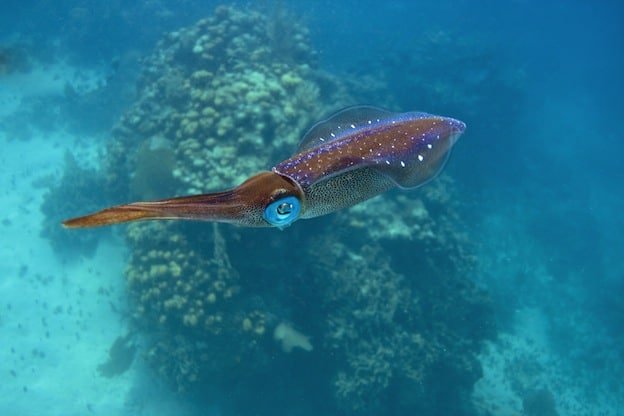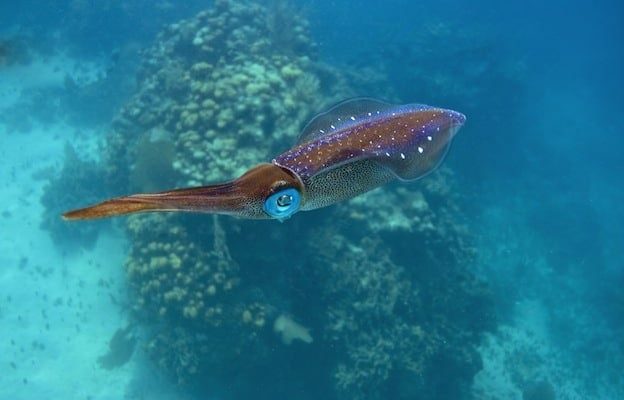
You might be wondering, “Are squids only found in oceans?” or “What about rivers or other bodies of water?” The short answer is that squids primarily inhabit oceans and seas, but they also have interesting adaptations that allow some species to venture into different environments. Let’s dive into the different places where squids can be found and explore their unique habitats.
Oceans: The Primary Habitat for Squids
Squids primarily call oceans their home. They inhabit various depths and regions, from the sunlit surface waters to the darkness of the ocean floor. Different species of squids prefer different oceanic zones. The epipelagic zone, which is the top layer of the ocean where sunlight penetrates, is home to many squid species. Here, squids can be seen darting about, hunting for fish and other prey.
In deeper waters, squids can be found in the mesopelagic zone. This is where the light starts to fade and is often referred to as the twilight zone. Species like the vampire squid thrive in this area, showing that even in the dark depths, squids have adapted to survive and hunt efficiently.
Interestingly, some squids are skilled travelers. For instance, when they migrate, they can move between different oceanic zones, adapting to changes in temperature and pressure. This flexibility contributes to their success as a species.
Coastal Areas: Where Squids Come to Feed
Coastal regions are another popular habitat for squids. These areas are often rich in nutrients, thanks to the mixing of fresh water from rivers and saltwater from the ocean. Squids can often be found in bays, estuaries, and even coral reefs. These settings provide ample food sources, like small fish and crustaceans.
For example, the common squid is frequently spotted near the coasts of Europe and North America. These squids often come closer to shore during specific seasons to feed and breed, making them easier for fishermen to catch.
The presence of seagrass beds and mangroves in coastal areas offers perfect hiding spots for juvenile squids. They can camouflage themselves among the plants to avoid predators, making these environments crucial for their early life stages.
Deep Sea: The Mysterious World of Giant Squids
When we think about squids, we can’t forget about the deep sea, home to the legendary giant squid. These formidable creatures can grow up to 40 feet long, making them some of the largest invertebrates on Earth. Living in the deep ocean, they thrive in extreme conditions, where light barely reaches and pressure is immense.
The bathypelagic zone—also known as the midnight zone—houses many unusual squid species. Here, bioluminescence plays a critical role. Some squids use it to attract prey or communicate with each other, creating an otherworldly spectacle in the dark depths.
Surprisingly, giant squids are not easily spotted. They prefer the remote areas of the ocean, making them elusive and mysterious. Researchers often rely on advanced technology to learn more about these creatures and their habitats.
Rivers and Freshwater: A Rare Sight
While squids are predominantly ocean dwellers, some species have adapted to live in freshwater environments. This is quite rare, though, and you won’t find squids in just any river. For example, the Oregonian squid and a few other species can tolerate brackish water, which is a mix of saltwater and freshwater.
Rivers provide a unique challenge for squids. They face different temperatures, salinity levels, and food sources than those in the ocean. When they do venture into freshwater, it’s usually to hunt or spawn. However, these occurrences are not common, and most people are more likely to encounter squids in oceans.
Adaptations: How Squids Thrive in Their Environments
Squids have some impressive adaptations that enable them to thrive in various habitats. For starters, their camouflage abilities are remarkable. They can change color and texture to blend in with their surroundings, which is crucial for both hunting and avoiding predators.
Additionally, squids have jet propulsion for swift movement. By expelling water through their bodies, they can quickly dart away from danger or capture prey. This ability helps them navigate through diverse environments, whether it’s the open ocean or the intricacies of a coral reef.
Another fascinating adaptation is their complex nervous system. Squids have a large brain relative to their body size, allowing for sophisticated behaviors and learning abilities. This intelligence is evident in their hunting strategies and social behaviors.
The Impact of Climate Change on Squid Habitats
Climate change is affecting many ocean habitats, and squids are not immune. As ocean temperatures rise and acidity increases, these changes can impact squid populations and their distribution. Warmer waters can alter their breeding cycles and migration patterns, making it essential for us to monitor these trends.
The effects of overfishing also play a significant role in squid populations. Many species are caught for food, and if not managed sustainably, these practices could lead to population declines. Understanding squid habitats helps researchers develop better conservation strategies to protect these fascinating creatures for future generations.
In summary, squids are remarkable creatures that inhabit a variety of environments. From the depths of the oceans to coastal regions and, occasionally, freshwater areas, they have adapted to thrive in many settings. Their incredible abilities, like camouflage and jet propulsion, give them an edge in their habitats.
Understanding where squids are found not only enriches our knowledge of marine life but also highlights the importance of protecting these environments. As we learn more about these amazing animals, we can appreciate the complexities and beauty of the underwater world. So, the next time you think about squids, remember that these agile creatures are a symbol of the ocean’s wonders, thriving in diverse habitats around the globe.

